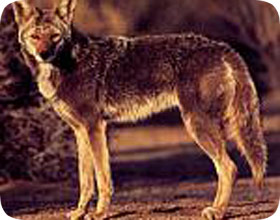- info@wildlife-removal.com
Call us for help in your town
Wildlife Removal Education
How to Catch a Coyote
Need coyote removal in your hometown? We service over 500 USA locations! Click here to hire us in your town and check prices - updated for year 2020.
 Coyotes, or ‘little wolves’, are actually timid creatures. They are skittish and nervous and do not like to be around people, although in some areas they are more accustomed to humans than others. Coyotes can range up to fifty pounds in weight and are responsible for helping out with the rodent problems in urban areas. They can run in packs or as a solitary individual, looking for food and adapting to the human environment. Despite some aggressive measures to control the coyote population, these resourceful little wolves are continuing to thrive as they learn to take advantage of their ever changing surroundings.
Coyotes, or ‘little wolves’, are actually timid creatures. They are skittish and nervous and do not like to be around people, although in some areas they are more accustomed to humans than others. Coyotes can range up to fifty pounds in weight and are responsible for helping out with the rodent problems in urban areas. They can run in packs or as a solitary individual, looking for food and adapting to the human environment. Despite some aggressive measures to control the coyote population, these resourceful little wolves are continuing to thrive as they learn to take advantage of their ever changing surroundings.
Click here for a nationwide list of 100's of professional coyote trappers serving all 50 states.
Coyote Nuisances -
Coyotes are not normally dangerous to humans and are not commonly known to attack humans. However, they do attack livestock including chickens, pigs and even cows. They also make meals out of your pets and eat pet food and other left-over foods. Their howling is akin to the sound of a baby crying and can be quite annoying when you’re trying to get to sleep.
Catching Wile-E-Coyote -
First of all, coyotes are wild animals and you should not attempt to capture one unless you are a professional. If you have a coyote problem, your best recourse is to contact a wildlife expert and let them handle the job.
However, if you are bound and determined to capture a coyote then there are some traps you can use. Traps are sold in outdoors outlets and through the humane society. Be sure that the trap you purchase is a humane one that includes rubber to help prevent unnecessary pain and wounds to the animal.
Before you set up your traps, make sure you know the laws of your area and state. Some states may require you to have a license for trapping and others may forbid it entirely. Next, you will need to locate the coyote’s trail or path. Coyotes are territorial and almost always return to ‘the scene of the crime’. In other words, if they absconded with your prized chicken the other day, chances are they will return to the same area as it has been established as a feeding area for them.
While you’re looking for coyote markings and footprints, also keep an eye out for other non-targeted animal’s prints. Raccoons and other animals frequent some of the same areas as coyotes and you do not want to capture the wrong animal with the wrong trap. It is also against regulations to set up traps that will be in the pathway of domestic animals and humans, such as in pastures for sheep and pigs. Some good places for traps would include intersections on farms, gates and edges of pastures where the other animals are not likely to travel.
Partially burying the trap is helpful as coyotes will look in the holes for prey. If you live in a climate that gets a lot of snow and/or ice, adding salt around the trap will help to keep it from freezing over and will provide a crusty coating over the trap to help camouflage it even more. Traps must be checked daily and kept clean.
Once you have captured the animal, call the proper authorities such as a wildlife expert to relocate the animal. Keep in mind that just because you caught a coyote doesn’t mean that you have caught the one responsible for killing your livestock. Contrary to popular belief, it is the male prime – a coyote about three years old – who is usually the culprit of killing larger livestock. Females, young and the older coyotes are usually responsible for small foul, small pets and rodents.
Capturing a coyote is not a good idea to do on your own. There are too many variables to take into consideration such as the laws and regulations in your area, accidentally capturing and hurting a non-targeted animal including a pet and many more unsavory challenges. Calling a wildlife specialist is really the best option.
However, you can help to reduce the coyote population in your area by securing their reason for being there; their food source. Make sure that the fences surrounding your livestock are sturdy and tall. Do not leave any food or garbage out that will attract the animals. Keep your pets inside at night to resist temptation for a tasty treat for the coyote. Do not leave pet food out to feed stray cats or other animals as this will also attract the hungry coyote.
For more information, go back to my main coyote removal page.


















